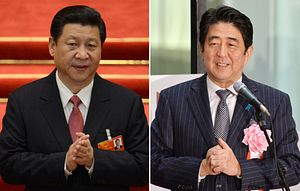China and Japan, Asia’s first and second largest economies, continue to view each other mostly with suspicion. According to public opinion research released last week by Pew Research Center, publics in both countries harbor largely negative sentiments toward the other, demonstrating that the disagreements between the two countries continue to delve far deeper than policy differences between their governments. Pew’s 2016 findings confirm an ongoing trend in poor mutual perceptions among the two Northeast Asian giants.
Specifically, 86 percent of Japanese hold negative views toward China and 81 percent of Chinese hold negative views toward Japan. In both cases, negative views have declined since their high in 2012, but the decline has been marginal. Pew asked respondents in both countries to associate adjectives with the other country, revealing interesting attitudes. 81 percent of Japanese said Chinese were “arrogant,” while 70 percent of Chinese said the same of Japan. Meanwhile, 76 percent of Japanese said that Chinese were “nationalistic,” while only 41 percent of Chinese had the same to say of Japan. Additionally, respondents in both country rated the other as “violent” (71 percent of Japanese, and 74 percent of Chinese) and “honest” (12 percent of Japanese, and 15 percent of Chinese) at relatively the same rate.
The views are explained by a range of issues, some longstanding and others fairly recent. Chinese skepticism and mistrust toward Japan has well-known origins in Japanese atrocities committed during World War II. Moreover, since 2012, when Japan decided to nationalize the disputed Senkaku/Diaoyu Islands in the East China Sea to prevent Tokyo’s nationalist former governor, Shintaro Ishihara, from purchasing them on behalf of the city, relations with China have grown increasingly strained. Japan administers the disputed islands and Chinese maritime law enforcement and naval vessels regularly approach disputed waters to assert Beijing’s claim. Though the East China Sea was a hotbed of activity between China and Japan primarily in 2013 and 2014, activity in the waters surrounding the Senkaku/Diaoyu Islands picked up this summer. Pew’s survey methodology notes that Japanese respondents were surveyed between April and May 2016, largely before the increased Chinese activity in the East China Sea.
Pew’s full survey report is worth reading for a range of other insights. For example, Pew found that supporters of the opposition in Japan were generally more favorable toward China than supporters of the right-wing Liberal Democratic Party, the party that’s been nationally dominant since 2012 and throughout most of Japan’s post-war history. Finally, Pew’s finding emphasize the continuing salience of history in dividing the two countries. For example, Pew finds that over the years, fewer and fewer Japanese respondents felt that their country had “not apologized sufficiently” for “its military actions during the 1930s and 1940s.” In 2016, the number stood at just 23 percent, down from 28 percent in 2013. In China, meanwhile, only 10 percent believe that Japan has apologized sufficiently, with 77 percent of respondents noting that Tokyo has been insufficiently apologetic.

































